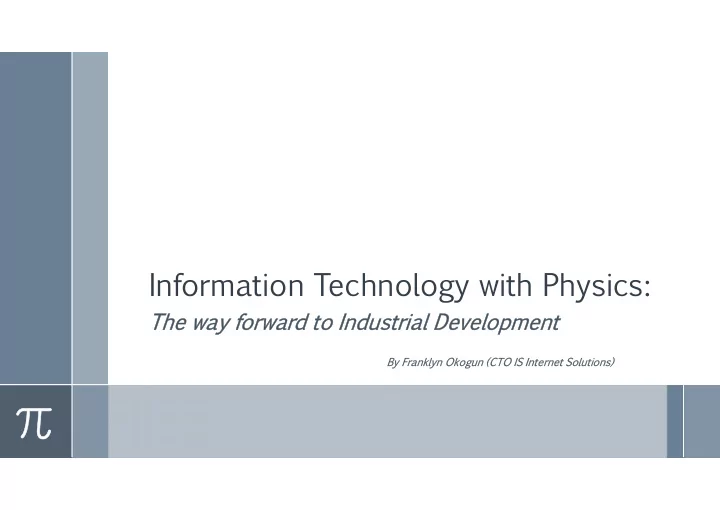

Information Technology with Physics: The way forward to Industrial Development By Franklyn Okogun (CTO IS Internet Solutions)
Content › Basic Definitions › Information Technology › Contributions of Physics to the Information Age › Real Life Application › Discussion
Definitions › Information technology (IT) is the application of computers and telecommunications equipment to store, retrieve, transmit and manipulate data, often in the context of a business or other enterprise › According to the Information Technology Association of America , Information Technology is define in the business context as "the study, design, development, application, implementation, support or management of computer- based information systems"
IT Areas of Importance › Business › Education › Finance › HealthCare › Security
Advantages and Disadvantages Advantage › Increased globalization › Cheaper, easier and faster communication(Skype, Social media) › More cost effective Businesses(Streamlining business) › Bring Business Nearer the people(e- commerce) › Creation of new jobs (Programmers/software developer, systems design/analyzers, hardware design, and web designers etc.) Disadvantages › Rise in unemployment
Contributions of Physics to the Information Age Computers The first electronic digital computer was built in the basement of the physics department at Iowa State University in 1939 by Professor John Atanasoff, who had a Ph.D. in theoretical physics from the University of Wisconsin, and his physics graduate student Clifford Berry. The second electronic digital computer, also proposed and designed by a physicist, was completed in 1945. This computer, called the ENIAC, was largely based on Atanasoff' s pioneering work.
The Transistor: This was discovered in 1947 by young physicists (John Bardeen, Walter Brattain and William Shockle) at Bell Laboratories in New Jersey. This gave birth to amplification using semiconductor And this garnered them the Nobel Prize in 1956 and opened the way to the telecommunications revolution and the information age.
The World Wide Web: In the 1980s, the thousands of physicists at CERN Particle Physics Laboratory in Geneva needed a better way to exchange information with their colleagues working in different universities and institutes all over the world. To meet this need Tim Berners-Lee, a graduate from Oxford University with 1st class Honors in Physics, invented the World Wide Web at CERN in 1990. Along with creating the first web browser and web server, he developed the software conventions that are key to the Web's usefulness, with acronyms like URL (uniform resource locator) and HTTP (hypertext transfer protocol). Lasers: In 1954 the first microwave laser was built by physicist Charles Townes. While the first optical laser was built in 1960 by physicist Theodore Maiman.
SATELLITE COMMUNICATION
MICROWAVE TRANSMISSION
OPTIC FIBRE
MEDICINE
DISCUSSION
THANKS
Recommend
More recommend